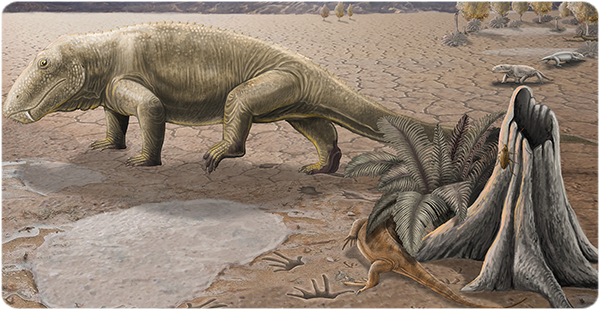 A study led by researchers from the Institut Català de Paleontologia Miquel Crusafont published in Palaeogeography, Palaeoclimatology, Palaeoecology describes the environmental and faunal changes that took place between 290 and 270 million years ago in the current region of Berguedà (Catalonia, North-East Spain). The Permian sedimentary deposits in this area reveal a transition from a landscape with rivers and floodplains to a more arid environment with a monsoonal regime. In parallel, the fossil footprint record indicates a faunal shift where amphibians disappeared.
A study led by researchers from the Institut Català de Paleontologia Miquel Crusafont published in Palaeogeography, Palaeoclimatology, Palaeoecology describes the environmental and faunal changes that took place between 290 and 270 million years ago in the current region of Berguedà (Catalonia, North-East Spain). The Permian sedimentary deposits in this area reveal a transition from a landscape with rivers and floodplains to a more arid environment with a monsoonal regime. In parallel, the fossil footprint record indicates a faunal shift where amphibians disappeared.
Researchers from Museu Balear de Ciències Naturals (MUCBO) and Institut Català de Paleontologia Miquel Crusafont (ICP) have described the new reptile species Tramuntanasaurus tiai based on a well-preserved fossil skeleton found in rocks from Mallorca dating back approximately 270 million years. The research has been published today in the journal Papers in Palaeontology.

An international team including researchers from the Institut Català de Paleontologia Miquel Crusafont (ICP) describes a new type of footprints for science in the Alta Val Maira (western Alps, Italy). The tracks were made by a large reptile that lived in this area about 250 million years ago, when the Alps had not yet formed and probably was a coastal area with a nearby river delta. The find is exceptional because until now it was considered to be an inhospitable area as a consequence of the Permian-Triassic mass extinction.

A team of researchers from the Department of Geology at the Universitat Autònoma de Barcelona (UAB) and the Institut Català de Paleontologia Miquel Crusafont (ICP) recently published in PLOS ONE the description of a large set of tracks made by archosauromorphs, reptiles which later evolved into crocodiles and dinosaurs. Among the tracks, there is evidence of a new species, the Prorotodactylus mesaxonichnus, which corresponds to a reptile which lived in the Pyrenees some 247 to 248 million years ago, but which was not related to any dinosaur.







